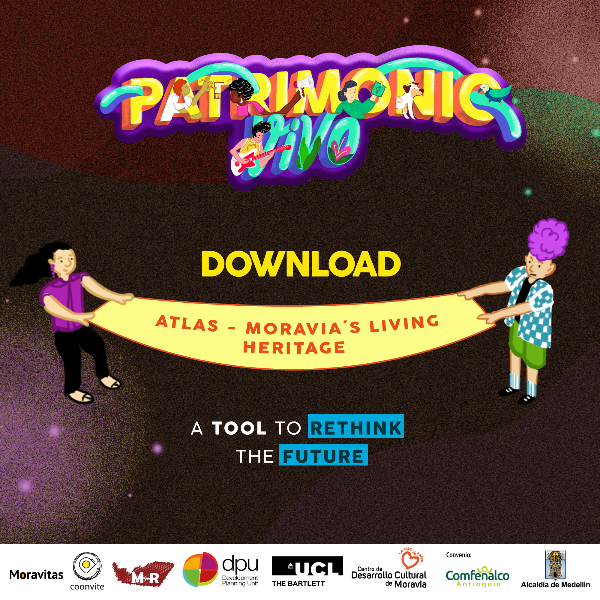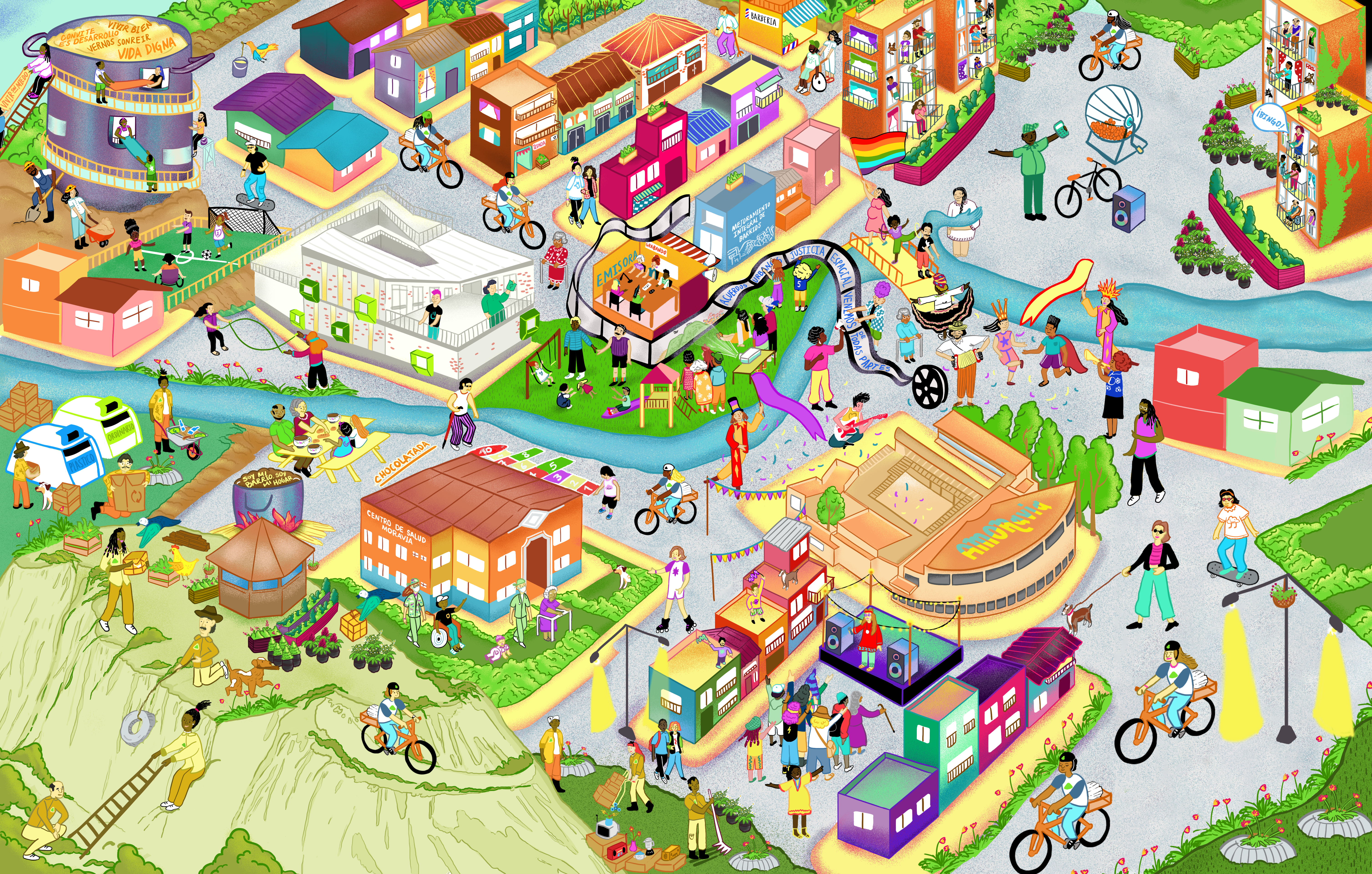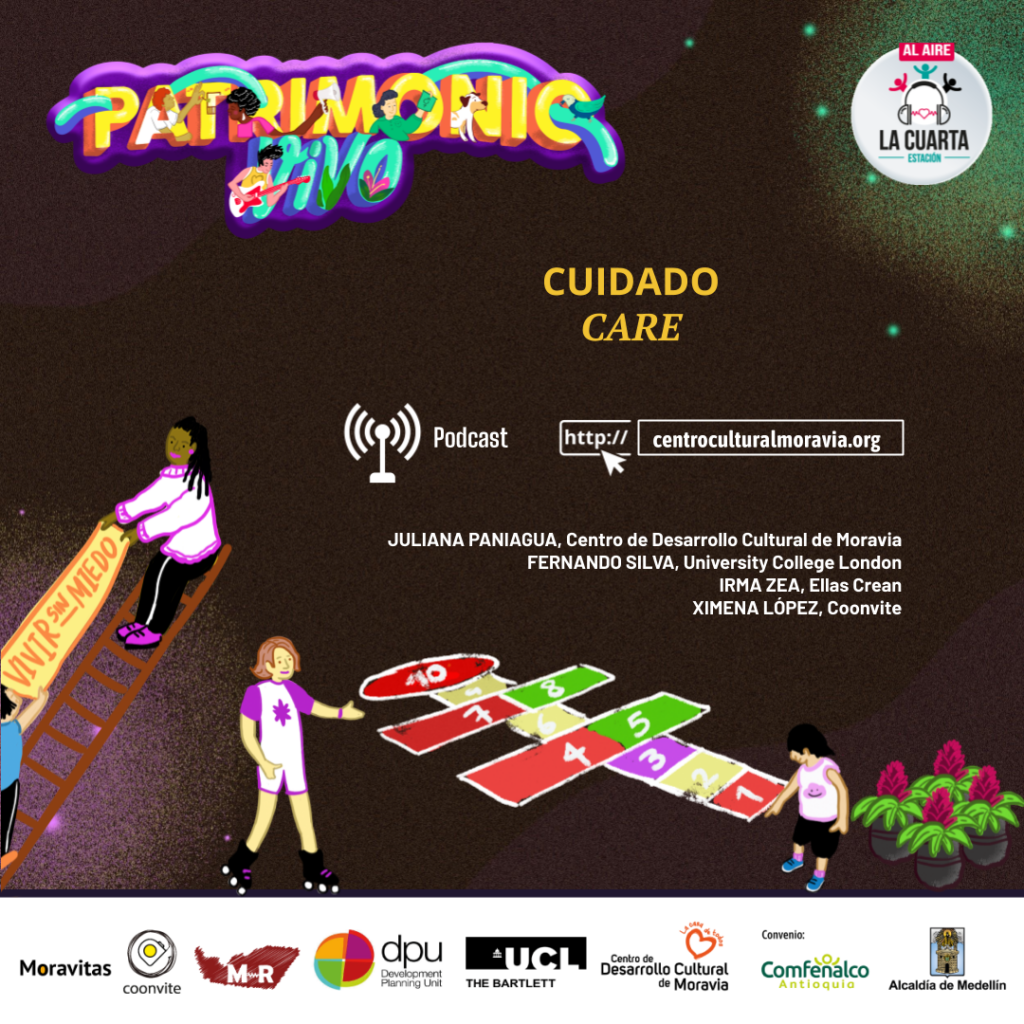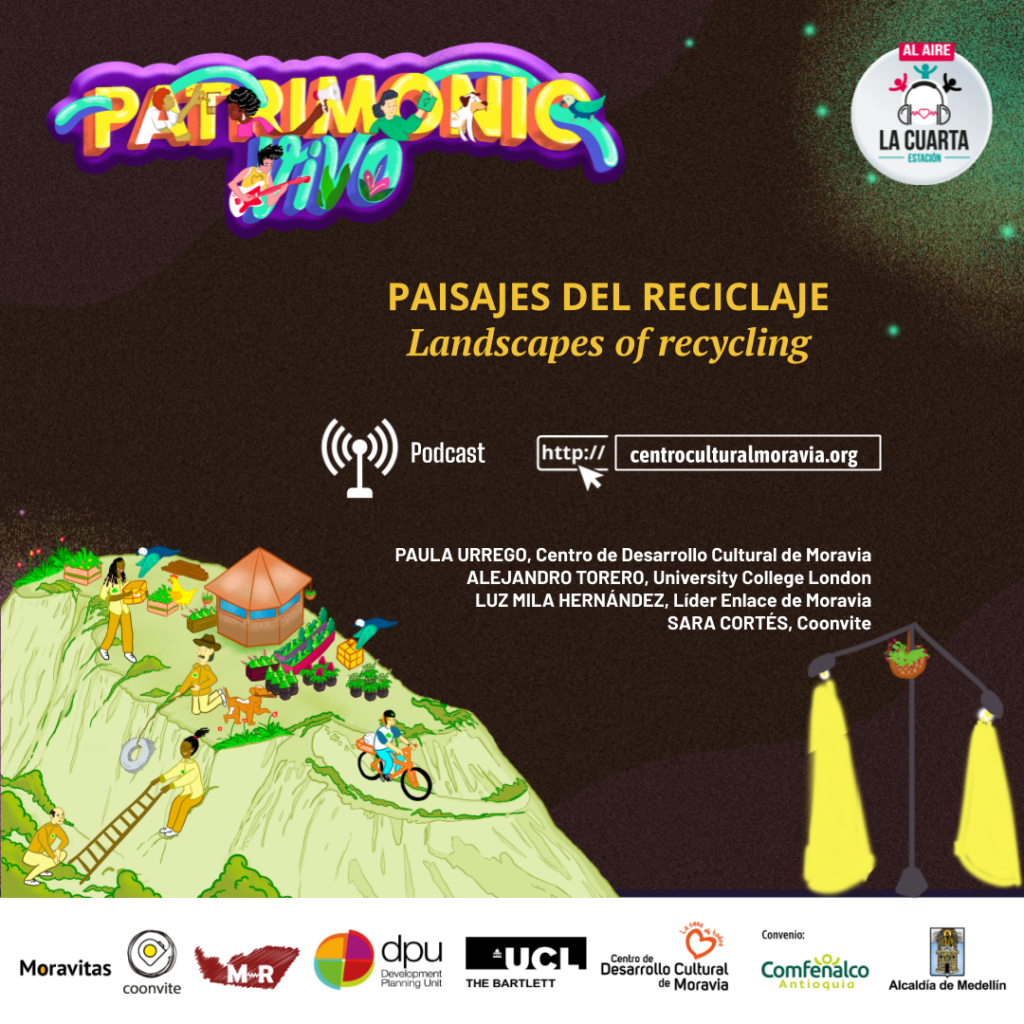Moravia’s Living Heritage – A tool to rethink the future
How to frame Moravia as living heritage?
What type of socio-spatial strategies can be imagined to respond to urban transformation?
For 4 weeks, students explored the vast spectrum of political issues working in the multidimensional field of urban development and socio-cultural heritage and investigated specific design strategies and interventions within existing governance structures and processes.
The project focused on exploring the living heritage through four thematic lenses that our partners selected according to their particular challenges and needs. The four specific thematic areas of research are the following: 1) Care systems, 2) Memory and migrations, 3) Recycling Landscapes, 4) Community communication. These four analytical and thematic lenses have been explored through cross-cutting issues, particularly the notion of co-creation, the approach of urban pedagogies, and storytelling as a powerful tool for research.

An ATLAS to recognize, resignify, and project future life!
Communication and community connections – Podcast
What is the potential of Communications to engender inclusive urban transformations? Communications allow us to question and confront the logic underlying any change: ideas. This chapter proposes a Communications strategy to build agreements through spatializing, comprehending, bettering conversations, showing the valué and disseminating the convites of Moravia as an alternative of
innovation, and community development.
“El convite” understood as an act of community fabric that arises from the interaction between neighbors who create solutions to live the neighborhood life well. Through the messages, strategies, and encounters of the convite in its various forms (self-construction, resistance, culture, mutual aid, among others), we show how to visualize and project the value of the community narratives, actions, and fabrics, as tools for resilience and change vis-á-vis the threats that put their integral upgradings at risk.
Spanish podcast
Memory and Migrations – Podcast
This brief compendium has been produced with the aim to recognize and to visualize the distinct socio-spatial practices that, throughout time, have contributed to shaping Moravia’s territory and also constitute the living heritage of Moravia. This work emerges from the collaboration between neighborhood leaders, residents, grassroots organizations, academia, and members of the CDCM.
This work attempts to understand how the evolution of Moravia is linked to continuous waves of migration and how these are the product of different internal conflicts which have affected Colombia through the years. Similarly, it tries to emphasize the centrality of the role of memory within the neighborhood (both collective and individual) as a dispositif through which future urban transformations could be approached with a view to safeguarding the continuity of the territory.
To a large extent, the document takes from the various narratives circulating on the streets of Moravia, which every day are engulfed by a diverse range of characters, who make the social fabric of the neighborhood. In this sense, cultural diversity is highlighted as one of the engines that powers the vitality of the community, not to mention Moravitas’s capacity for self-management, the richness of popular knowledge and the different cultural expressions that position Moravia as a point of reference for the city.
This work advocates for the recognition of Moravia’s social assets as both its living heritage and its legacy for the construction of the city. The strategy revolves around three axial points: to emphasize the contribution of migration for the construction of Moravia’s territory, to foster the identity of Moravia as a host community and to highlight the valué of social Innovation within the neighborhood.
By advancing three strategic actions on the territory, this work aspires to address not only some of the socio-spatial problems currently affecting the neighborhood but also to create a platform on which to medíate the continuation of Moravia as a focal point in the urban landscape of Medellin.
In this spirit, it is hoped that this work will help in adding valué as well as in making visible the living heritage of Moravia and contribute positively to the process of making the city.
Spanish podcast
Systems of care – Podcast
Care as a concept refers to all those vital labors and discourses engaged in maintaining lite. In Moravia, it stands as a set of feminized, collective, and continuous actions performed to sustain and endure life within the neighborhood. Care Systems are an integral part of Moravia, engendering an interconnected network created through mutual assistance between the community. The formation of networks of collective support stems from a condition of vulnerability and violence, as a result of the wider political context characterizing the city of Medellin and the country at large. Within this scenario, the sheer act of reproducing and maintaining life stood as an act of resistance against violent power dynamics. The active will of preserving life under these circumstances, through a matriarchal social structure, engendered an increase of political agency of the community. Therefore, out of necessity, the territory was shaped, built, and organized on communal leaderships of care, in which female leaders played a fundamental role. The history of Moravia is inevitably tied to episodes of conflict and trauma, but the ethics of care produced and redistributed daily by the neighborhood’s matriarchy enabled not only the existence but also the development of the community and its members. Because of its strong relation with intimacy, care as both a concept and a practice has been relegated to the domestic sphere by mainstream narratives which then tend to invisibilize its social valué.
The matriarchal social structure of Moravia has applied the concept of care at the core of its ethos, and by these means managed to achieve political leverage by operating not only on a neighborhood level but also on a city-wide scale. In this sense, care becomes a crucial aspect within the process of recognition for the neighborhood community. We chose to explore three areas of care practices that opérate on Moravia: Care of public spaces and communal life, Soft networks and infrastructures of Care, and Communal leadership and care for the caretakers. Through these continuous practices, the Living Heritage of Moravia as múltiple networks of care can be recognized and strengthened in future urban transformations.
Spanish podcast
Landscapes of recycling – Podcast
This chapter proposes a human-centered and systemic lens to understand the constitution of the recycling landscapes in Moravia and Medellín. We will demónstrate how everyday recycling practices of Moravitas recycling workers can be framed as living heritage. We created a detailed inventory of the practices and knowledge, held by the inhabitants of Moravia, which is relevant for the support of the city.
Waste management and recycling are practices that tend to be invisible for most citizens and most forms of urban planning and design. The objective of this chapter is to make visible the relevance of Moravia’s inhabitants’ traditions of recycling as a living heritage that has been fighting climate change and environmental degradation for decades.
Nowadays, the neighborhood faces new existential challenges: from the Urban renovation plan proposed by the municipality of Medellín, to the Covid-19 pandemic. Nonetheless, due to these challenges, we have unprecedented opportunities to reimagine the Systems that shape our cities and mitígate inequality. With that in mind, we propose five strategies that build on Moravia’s living heritage of recycling and emphasizing the continuity of the community-led initiatives. The long term goal is to recognize and replícate this heritage throughout the city and allow a just circular economy to emerge.
Spanish podcast
Improvement without displacement for the future of Moravia

Moravia is not a neighborhood of invasion; it is a neighborhood built with the own hands and voices of the people who populated it and continue to populate it because of the social inequality that exists in the country. The future of Moravia, as well as its past and present, is in the processes of agreement and the evaluation of community learning.
This drawing represents the film that we all build when we listen to the oral stories recorded in files of multiple formats, especially in photography and video, which tell of the struggles, resistance, and resilience of a diverse community. The recycling landscapes projected as waste cooperatives inspired by real experiences of community organizations such as Jarum and Cojardicom. Care, as an urban system applied to the neighborhood, is represented through a network of protective environments resulting from the urban agreements reached between the community and the local government. Also, we can see women as protagonists in the type of work carried out for years without remuneration: caring for the family and neighborhoods in the case of women leaders. Care is also manifested in the dynamics of peaceful coexistence and in the active inclusion of all the people who inhabit the territory, recognizing their identity and expression of gender, origin, age, and knowledge. Communications and community connections are the forms of “convites.” The pot
of “sancocho” as a metaphor of common physical spaces built by the community, such as the community center or the football field. “La chocolatada” or chocolate pot shared in the community meetings, where messages and declarations about the neighborhood are also written. The carnival and “el sainete” questions patriarchal power relations, and redefines traditional culture through dance, theater, and music. Mutual
help experienced in a community bingo, as a sample of the essence of a neighborhood thought, built, and dreamed with #AMORavia.
Broadcasting: Moravia and its living heritage – May 21, 2020
Five perspectives of Living Heritage in Moravia are raised in this conversation: spatialization of living heritage, cultural and artistic management, narratives for change, neighborhood architecture, and community fabric.
- Luz Mila Hernández – Member Moravia Resiste
- Juan Miguel Gómez – Director of the Coonvite Architecture Cooperative
- Catalina Ortiz – Associate Professor University College London
- Ana María Restrepo – Coordinator of the Cultural Development Center of Moravia
- María Juliana Yepes – Communicator Center for Cultural Development of Moravia
Territorial commons – May 27, 2020
We are part of a common good woven in the past, present, and future. We will get to know first-hand the findings and reflections of the 100 years investigation of the Northeast Zone and the Living Heritage of Moravia project as a tool to rethink the urban future.
- Davison Zapata – Community Manager of the Luis Ángel García Bustamante Meeting House
- Diana Carolina Giraldo – Researcher 100 years of the Northeast Secretariat of Citizen Culture
- Catalina Ortiz – Associate Professor University College London
- Luz Mila Hernández – Member Moravia Resiste
- Moderator: María Juliana Yepes – Moravia Cultural Development Center
A dream of dignity – June 5, 2020
Song created by the Ensemble of the project “Living Heritage of Moravia as a tool to rethink the urban future”.
- Composition and leading voice: César Restrepo, Sr Montes, Irma Zea, Manuela Vásquez.
- Music (Arrangement): César Restrepo.
- Production: César Restrepo, Sr Montes.
- Piano: Boris Zapata.
- Guitar: Julián Salazar.
- Drums: Sebastián Ramírez.
- Congas: Omar Corona
- Choirs: Naiara Yumico, Ana Restrepo, Ivonnet Quiroz, Daniela Hinestroza, Paula Urrego, Laura Echeverri, Johana Espinosa, Eliana Cardona, Irma Zea, Manuela Vásquez, Catalina Ortiz, Laura Gaviria, César Restrepo, Boris Zapata.
“We inhabit turbulent times. We had the privilege to activate a co-creation process whose results we present in this publication. This collective work focuses on learning together about understanding Moravia (Medellin) as a living heritage of the city and imagining the possibilities of envisioning urban futures. To discuss living heritage is the celebration of life itself, but we cannot forget that death haunts us, so we must feel the losses, the uncertainty, and mourning around us. This celebration then is also in some way a healing ritual, to honor the ancestors, the racial diversity, and the knowledge of the neighborhoods.” Catalina Ortiz | Associate Professor |Program Leader MSc Building in Urban Design for Development
Alianza para el aprendizaje
Expanded messages
UN Habitat praises the co-creation of a Living Heritage Atlas by MSc BUDD students and partners!@cataortiza @CulturalMoravia @MoraviaResiste @Coonvite @ONUhabitat @DPU_BUDD
The Living Heritage Atlas can be downloaded here: https://t.co/BnPFy6GBEdhttps://t.co/Xr5kHjPcXO pic.twitter.com/5eNlAm1Dqo
— Dev. Planning Unit (@dpu_ucl) June 23, 2020
Cuando comunidades empoderadas cuentan su historia y esta se vuelve su patrimonio, los proyectos de desarrollo local cobran sentido, como en este caso, Moravia, Medellín.
Gran trabajo de esta comunidad con @coinvite @cataortizahttps://t.co/VUkJ5JegUy
El barrio de Medellín que está inspirando a la ONU y a toda Latinoamérica. https://t.co/bd0PBgNsT5@CulturalMoravia @MoraviaResiste @coonvite @cataortiza @dpu_ucl pic.twitter.com/Mb82ploY0h
— LA Network (@La_network) June 14, 2020
— Elkin Velásquez (@ElkinVelasquezM) June 6, 2020
Estamos felices porque comienza el proyecto #PatrimonioVivo, como herramienta para pensar el futuro urbano. Junto a @DPU_BUDD @MoraviaResiste @coonvite y #ComunidadesActivas de #Moravia.https://t.co/7UWye6OqWj
MAÑANA | Celebramos la co-creación de un inventario de prácticas y estrategias para salvaguardar los
procesos comunitarios y las transformaciones territoriales de #Moravia. #ATLASPatrimonioVivo como una herramienta para re-pensar el futuro. #NosMueveLaCultura pic.twitter.com/sdwRkW3zfq— Centro Cultural Moravia (@CulturalMoravia) June 4, 2020
— Centro Cultural Moravia (@CulturalMoravia) May 4, 2020
Junto a @cataortiza y estudiantes de @DPU_BUDD comenzamos proyecto de #PatrimonioVivo entre el @CulturalMoravia ,habitantes de #Moravia, voluntarios de @coonvite. #Memoria, #Cuidado, #Comunicación #PaisajesdelReciclaje https://t.co/8FEwDWnYPt
— María Juliana (@MariaJulianaYB) May 5, 2020
Una nueva edición de la revista ¿Qué Pasa? Que cuenta en las.vices comunitarias los ejercicios de resignificación sobre el mejoramiento de sus barrios: concertados, comunitarios y coproducido. #Moravia #PatrimonioVivo https://t.co/8MmWErifWY
— María Juliana (@MariaJulianaYB) May 5, 2020
La revista ¿Qué Pasa? llega a su edición 31 que enfoca su contenido en las comunidades activas de Moravia frente al proceso de Renovación Urbana. https://t.co/E68ZZJ7CXc #Moravia #MejoramientoIntegralBarrios #DerechoalaCiudad pic.twitter.com/VOrhM92eQL
— Centro Cultural Moravia (@CulturalMoravia) May 4, 2020




